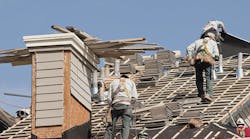Several components of the built environment can be reused or repurposed – carpet, furniture, and even electronics. But to really close the loop of recycling, you’ve got to consider what’s over your head.
Environmentally responsible ways to dispose of roofing are on the rise. Methods are becoming so commonplace that overlooking and forgetting are no longer excuses. First learn how to go about recycling roofing, and then consider the potential of what can be done with it.
Use Responsible Installers and Suppliers
Do a bit of groundwork by finding out what’s available. Some good starting places include 1-800-CLEANUP, www.earth911.com, and www.shinglerecycling.org. There are several groups dedicated to keeping construction and demolition materials out of the dump.
If green building certification is a goal, a designer or sustainability consultant can make sure that roof recycling is written into the project. But as roof recycling is increasingly becoming the norm, you don’t need too much outside help.
“A criteria for selecting a contractor should be whether they can help you recycle the roof, so ask them,” advises Jim Kirby, vice president of sustainability at the Center for Environmental Innovation in Roofing. “A piece of roofing needs to be separated into clean material by removing fasteners, nails, and adhesives. More and more, contractors are performing this work and using it as a sales tool. Years ago, they thought it would add cost to the job, but now they have partners and they do it all the time.”
In many cases, contractors are sponsored by or affiliated with certain manufacturers, explains Maciek Rupar, technical director at the National Roofing Contractors Association.
“If a contractor is specific to a manufacturer, he should be aware of what they can do in terms of recycling,” Rupar adds. “These programs are supported by manufacturers, so start the conversation.”
Consider Your Existing Material
Regardless if your existing system is asphalt, metal, or membrane, there are options available. “You can get into the minutiae of what is recycling vs. downcycling, and pre- vs. post-consumer, but as long as it doesn’t get into the landfill, that’s all you should really care about,” Kirby says.
Asphalt shingles can be mixed back into hot asphalt and used for bike paths and playgrounds. Some states even allow roadways to contain up to 5% of recycled asphalt, adds Kirby.
The specific type of membrane dictates how it can be repurposed. Manufacturers like Sika Sarnafil, Duralast, Firestone, and Carlisle Syntec will take back their own membranes, grind them down, and reintroduce them into the manufacturing process, explains Rupar. Recycled membrane material doesn’t go into the exposed roof but instead constitutes the backing or becomes a roof walkway.
“I’ve also heard of this material becoming a kind of crumb rubber that I’ve seen around the climbing walls at my gym. It can even go into car bumpers,” Rupar adds.
Responsible disposal doesn’t have to be an intensive process. If options are limited, focus on reuse instead of recycling.
“In the Midwest, there is a lot of rock on roofs. Rock is rock is rock,” says Kirby. “Why can’t that rock go into landscaping efforts on your property? Maybe it can be your new driveway.”
Encouragement through Economics
“The motivation has to start with wanting to be environmentally conscious,” says Reed Hitchcock, executive vice president of the Asphalt Roofing Manufacturers Association. “Explore your options, because there are many beneficial uses for these materials even after they’re no longer useful at your building. All of us owe it to ourselves and the environment to find those.”
But often, the green that owners care about is money, not Mother Earth. “Recycling simply makes the most economic sense, and that’s what matters to most people,” Rupar says.
In many U.S. regions, dumping fees are more expensive than recycling methods. Even landfills perform some material segregation themselves because it represents an income stream. “If you could either pay to unload 20-yard dumpsters full of shingles into the landfill or take them to a recycler and get paid to do it, what makes more sense to you?” asks Kirby.
Even just 10 years ago, many of these options didn’t exist. But now, you don’t have to look very hard to find them.
“Roof recycling is becoming common enough that building owners should be requesting it,” Kirby explains. “It’s certainly not cost ineffective to do it.”
Chris Curtland [email protected] is assistant editor of BUILDINGS.


![Maple Leaf Foods Ontario[2] Maple Leaf Foods Ontario[2]](https://img.buildings.com/files/base/ebm/buildings/image/2022/06/16x9/Maple_Leaf_Foods___Ontario_2_.62a0caaf6297f.png?auto=format,compress&fit=fill&fill-color=white&q=45&h=139&height=139&w=250&width=250)